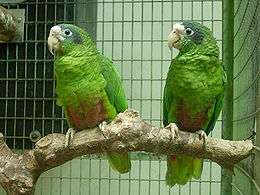Hispaniolan amazon
The Hispaniolan amazon or Hispaniolan parrot (Amazona ventralis), colloquially known as cuca, is a species of Amazon parrot in the family Psittacidae. It is found on Hispaniola (Haiti and the Dominican Republic), and has been introduced to Puerto Rico. The main features that differentiate it from other amazons are the white forehead, pale beak, white eye-ring, blue ear patch, and red belly.
| Hispaniolan amazon | |
|---|---|
 | |
| Scientific classification | |
| Kingdom: | Animalia |
| Phylum: | Chordata |
| Class: | Aves |
| Order: | Psittaciformes |
| Family: | Psittacidae |
| Genus: | Amazona |
| Species: | A. ventralis |
| Binomial name | |
| Amazona ventralis (Müller, 1776) | |
Its natural habitats are subtropical or tropical dry forest, subtropical or tropical moist lowland forest, subtropical or tropical moist montane forest, and plantations. It is threatened in its home range by habitat loss and the capture of individuals for the pet trade.
The presence of this bird outside of Hispaniola is due to it being introduced, this in part from a release of birds raised in captivity as a studied rehearsal for the re-colonization program of the highly endangered and related Puerto Rican amazon.
Habitat and distribution
As with other amazons, it prefers forested areas where food is plentiful. This parrot lives in the various forest biomes of Haiti and the Dominican Republic, albeit much more common in the latter. However, over the recent years, they have been captured out of their natural habitat illegally to keep them as pets, which are very popular in the Dominican Republic. Currently, the population ranges from 10,000 to 19,000 individuals in the wild and decreasing.
The declining population of Hispaniolan amazons are found in a small area of Haiti, most of the Dominican Republic, and a few offshore islands. It has been introduced to Puerto Rico.
Description
Its plumage is green, and most feathers are edged with blue. It has a distinct white forehead and area around the eyes; some blue patches on cheeks and crown; a red patch under the chin; and black ear coverts. This amazon also has red feathers on its abdomen; blue wind coverts; green edging to the outer webs; yellowish green plumage under the tail; an upper-side green tail with yellow tips; red outer tail feathers at base; a horn coloured bill, and brown irises with pale feet. Its body length is about 28 cm long. An average adult weighs 250g (8.75 oz), and has a heavy and powerful beak; their bite has been noted to cut open skin and cut deep.
Although a relatively common amazon, due to habitat loss, hunting, and trapping for aviculture, the wild population is declining sharply. Their ability to imitate human speech and intelligence makes them prime targets for the illegal pet trade. These amazons prefer to be either in small groups or pairs. They are noisy and cautious, spending the greater part of their days eating and resting in trees. When in flight, they have a very heavy wing beat, and are slow. They feed on fruits, berries, seeds, nuts, and possibly flowers, and constantly chatter while feeding. They have been known to cause damage to banana, guava, maize and cactus fruit crops.
Breeding
These parrots create nests in tree cavities; the clutch ranges from 2 to 4 eggs maximum. The eggs hatch in about 30 days, and chicks usually fledge at 10 to 12 weeks of age. However, people often remove the newborns from the tree cavities, and destroy the nest that have been reused over the years, and afterwards, preventing the parrot from reproducing.
Breeding in aviculture is often not successful, and when they are in pairs, they need to be isolated; this is considered the main reason for the Hispaniolan amazon's declining population. They are hard to breed, and once accustomed to being pets, can not survive if released into the wild.
References
- BirdLife International (2013). "Amazona ventralis". IUCN Red List of Threatened Species. 2013. Retrieved 26 November 2013.CS1 maint: ref=harv (link)
External links
| Wikimedia Commons has media related to Hispaniolan amazon. |
- Species Factsheet, BirdLife
- Hispaniolan Amazon videos, images and sounds, Internet Bird Collection]
